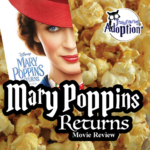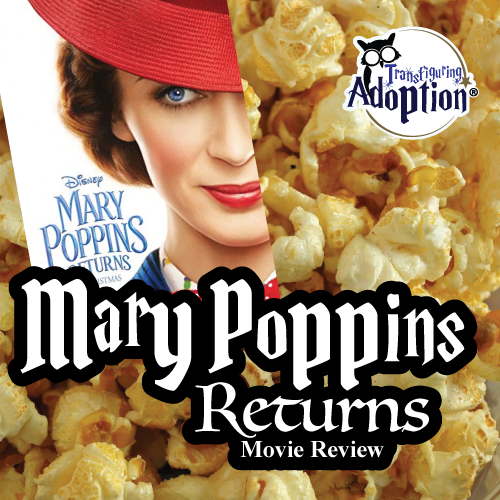
Mary Poppins Returns
Grade:
Transfiguring Adoption awarded this book 4 Hoots out of 5 based on how useful it will be for a foster/adoptive family. [Learn more about our Hoot grading system here]
Movie Info:
Synopsis from the Cover of Mary Poppins Returns by Walt Disney Pictures:
“In Disney’s “Mary Poppins Returns,” an all new original musical and sequel, Mary Poppins is back to help the next generation of the Banks family find the joy and wonder missing in their lives following a personal loss. Emily Blunt stars as the practically-perfect nanny with unique magical skills who can turn any ordinary task into an unforgettable, fantastic adventure and Lin-Manuel Miranda plays her friend Jack, an optimistic street lamplighter who helps bring light—and life—to the streets of London.”
Movie Info:
Grade:
Transfiguring Adoption awarded this book 4 Hoots out of 5 based on how useful it will be for a foster/adoptive family. [Learn more about our Hoot grading system here]
Transfiguring Adoption Thoughts:
This film follows the plights of a new generation of Banks children as we find the whole family attempting to carry on with life after the loss of Michael Banks’ wife. Mary Poppins returns to assist the family in moving through their grieving process and to see them through the fear of losing their home.
The movie offers viewer a spectacularly colorful arrangement of costumes and characters along with clever music reminiscent of the original Disney classic.
As with most movies this piece was not created specifically for use for foster and adoptive families. However, it does pose topics which could bring about healthy conversations for upper elementary school students all the way through high school students.
** Spoilers Could Be Ahead **
How Is This Relevant To Adoption & Foster Care?
While the family features a biological family, foster and adoptive families are going to want to pay attention to the themes of loss, grief, family teamwork, and family roles that play out throughout the film.
In the movie the Banks family is coping with the passing of Mrs. Banks which leaves Michael Banks as a single father. The family is also struggling to navigate a course in life where the bank doesn’t repossess their home. As foster and adoptive children have suffered great losses in life, healthy conversations can be constructed around the similarities to how your child and the Banks family must feel with situations of loss.
Due to the family’s struggles with coping with losses the Banks children appear to be caring for their grieving father. Essentially, the children have become adults and are taking on such tasks such as securing groceries, making phone calls to handymen, and even striving to figure out how to save their house from being repossessed. Foster and adoptive children will be able to relate in part to the Banks children, as many children from traumatic backgrounds have had to be acting as adults on duty in the absence of someone who could care for them. Mary Poppins Returns will allow foster and adoptive families to explore/converse about the roles of a child in a family and the role of a healthy & safe adult in a family.
Discussion Points:
- Family Roles
Children and parents have significant and distinct roles in a family. Unfortunately, past traumatic situations can cause the roles to be mixed up and blurred. Thus, foster or adoptive children may have found that they were expected or forced to take on the responsible adult role. Many foster or adoptive parents find that children who have taken on the role of adult have a difficult time trusting caregivers enough to give up this role and quite frankly they may have owned the role for so long that it is simply habit.
As was mentioned above, the Banks children are living in a household where they have taken on adult-ish roles to help fill in the gaps left by their departed mother. They can be found discussing budgeting money so that the family has enough groceries. The older children have several discussions attempting to figure out how to save the family home from being repossessed. The children even refuse Mary Poppin’s care at the beginning of the film as they feel they can care for themselves. While the specific situations may not reflect your child’s past situation, the overall tone, emotions, and themes will strike similar.
After watching this movie, caregivers will find that there is a great setup and atmosphere to talk about the responsibilities of children and parents in a “healthy” family. It would be great to discuss when points in the movie where the children were taking on their proper roles and pointing out when the adults were playing their proper roles. - Loss/Grief
As stated before in this review, all children from foster care or adoption have suffered at least the horrible loss of their birth parents and in many cases their heritage and family history and physical homes. Children from such experiences will be able to relate with the Banks children who are coping with the loss of their deceased mother and concerned about the repossession of their home.
Through the help of Mary Poppins the children come to the conclusion with their father that even though loved ones may be departed, the memory of them stays with us forever and is something we can hold onto. If your child is capable of discussing such a topic without being triggered, it would be worth discussing how you saw each person grieving during the movie. It is also worth noting that while the movie doesn’t address it directly, the family has been grieving for a while – meaning that your child should see that grieving is a process and not something that you get over in one night.
A theme such as the repossession of a home can be triggering and frightening for a child who may have experienced this firsthand. It would be worth discussing that the film depicts Michael and Jane having formed a plan where the family would move in with Jane as long as they needed to be there – meaning that the adults formed a plan to help solve a seemingly scary situation. The adults also made sure that everyone stayed together for this transition. Children from traumatic backgrounds have not always experienced this kind of stability. It might even be worth discussing what might happen if you did have to move to a new home or living space simply so your children can hear that you really could take care of the situation. Anxiety is usually calmed when we understand the problem and can see the promise of a solution. - Importance of Play
This point is simply enough. Children learn the best when they can play. They are able to discover their talents and abilities which help them secure their identity. They are able to learn from mistakes in a safe environment. It is imperative that children be allowed to play in order to grown into the role of a successful adult.
It would most definitely be worthwhile to discuss what the children learned from the various playful adventures they experienced with Mary Poppins. - Asking for Professional Help
There are times in which our foster or adoptive families need help from therapists, psychiatrists, doctors, etc. We require help because sometimes the issues and struggles are more than our family is equipped to handle.
The Banks family was in over their head with both the grieving of a deceased family member and the near loss of their home. Mary Poppins really played the part of not only a nanny but a therapist for the entire family.
If your child or family needs to see a therapist/counselor, this would be a great movie to discuss the normalcy of family’s sometimes needing an outside professional to help them through a difficult time.
Cautionary Points:
- Loss and Death
While we believe that this film can be an asset for speaking with your child about loss and death, it is worth noting that it could also be a trauma trigger for your child who has experienced extreme loss.
It’s interesting that while we recently reviewed a movie, [Spider-Man: Into The Spider-Verse], for which we more strongly warned about this theme. This film we would suggest has less of a threat. This is due to the fact that the Mary Poppins Returns seems to help the viewer work through these emotions, while other films simply present death/loss and expect the viewer to sort it out on their own.
It’s Your Turn:
- What was your favorite adventure the children went on in the movie? Why?
- How did the Banks kids act like adults? How did they act like children?
- Why did the family need Mary Poppin’s help?
- Is it ok for people to get or ask for help? Why?
- How did Michael Banks feel about losing his house? How can you tell?
- How did the children feel about losing the family home? How can you tell?
- Did the family look scared toward the end of the movie when they were leaving their home? Explain your answer.
- What do you worry about losing?
- How did the family feel about losing Mrs. Banks? How do you know?
- Do you feel like you have lost your birth family? How do you feel about this? Who are safe adults you can talk to about these feelings?
- (It is suggested to ask this question only if you are able to comfortably share with your child a generic plan for how you would work things out.)
Do you think your mom/dad/foster parents could keep everyone together if something were to happen to your home?
Transfiguring Adoption is a nonprofit organization seeking to nurture growth in foster and adoptive families by giving a HOOT about their families. Transfiguring Adoption does not intend for its reviewers nor its review to be professional, medical or legal advice. These reviews and discussion guides are intended to help parents to better be able to connect and understand their children who come from traumatic backgrounds.
